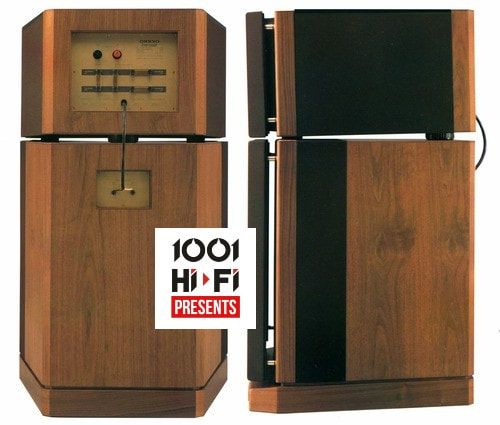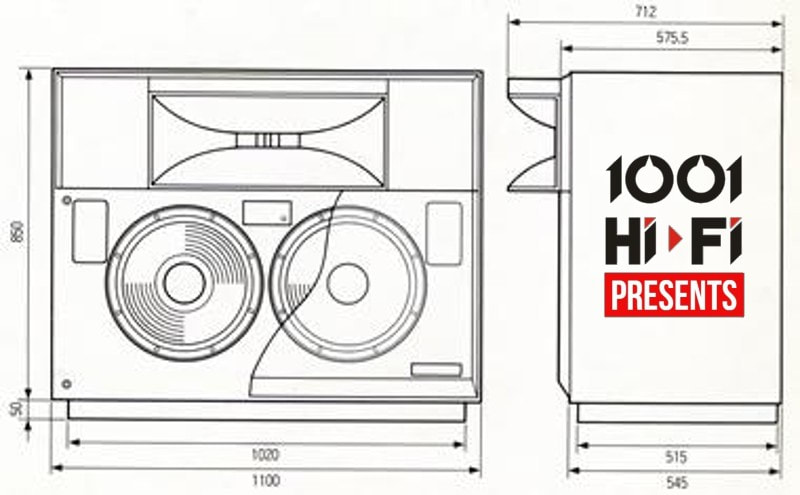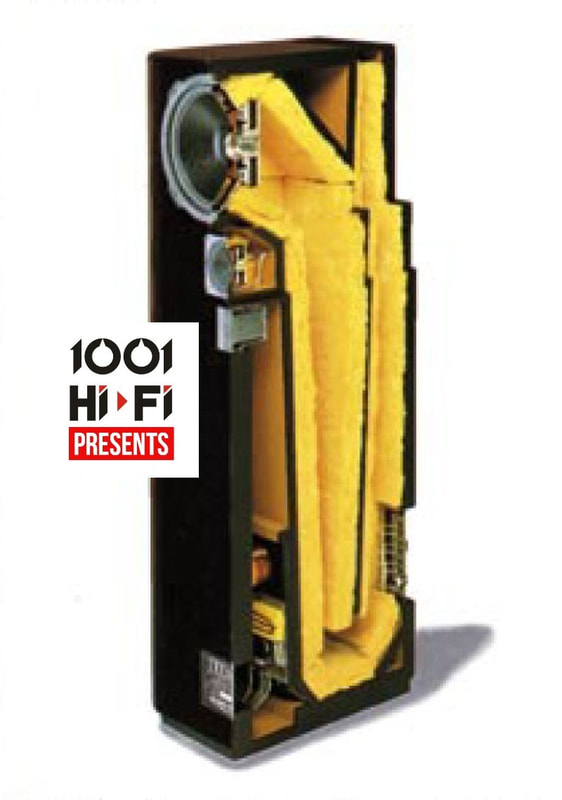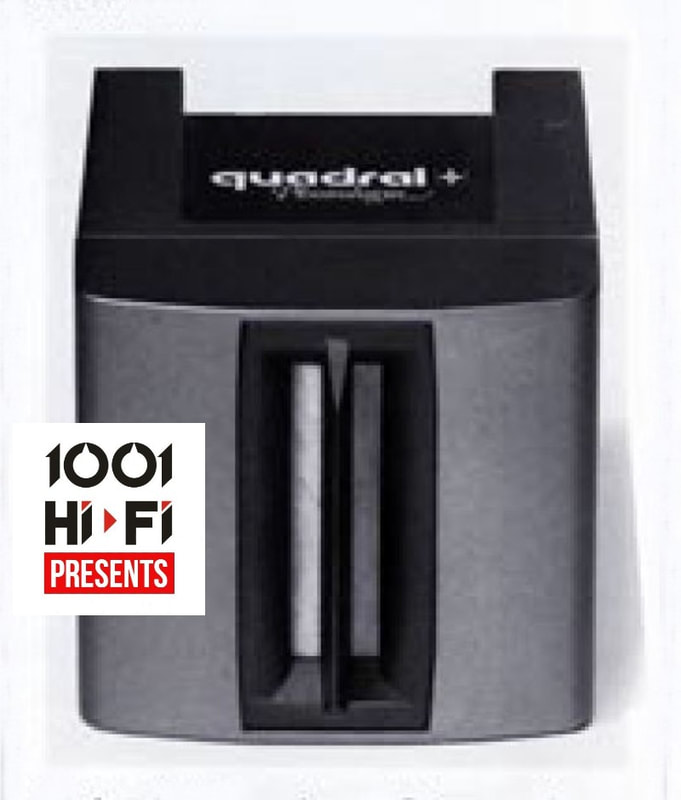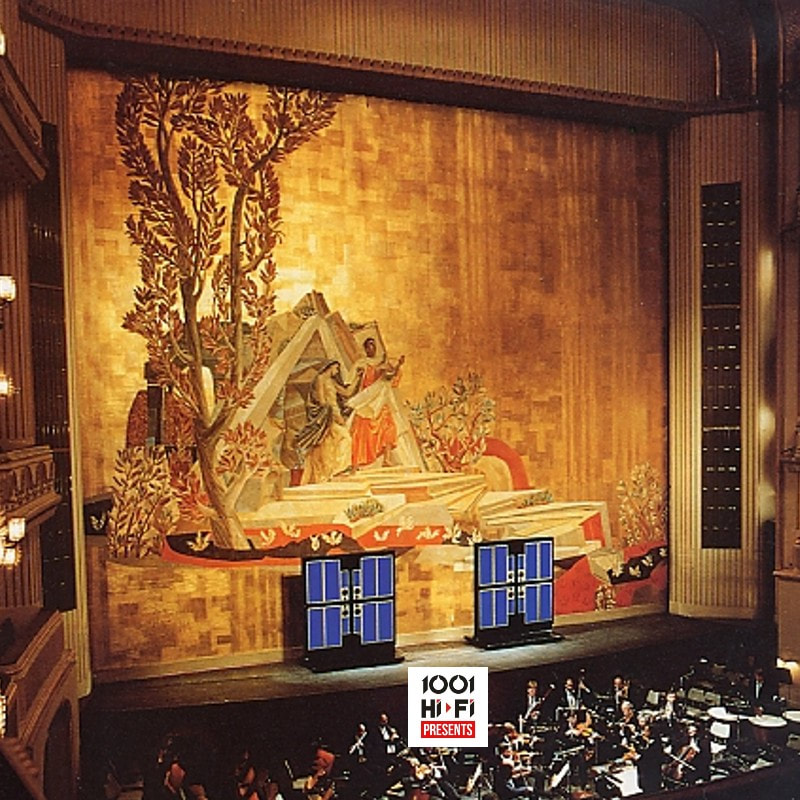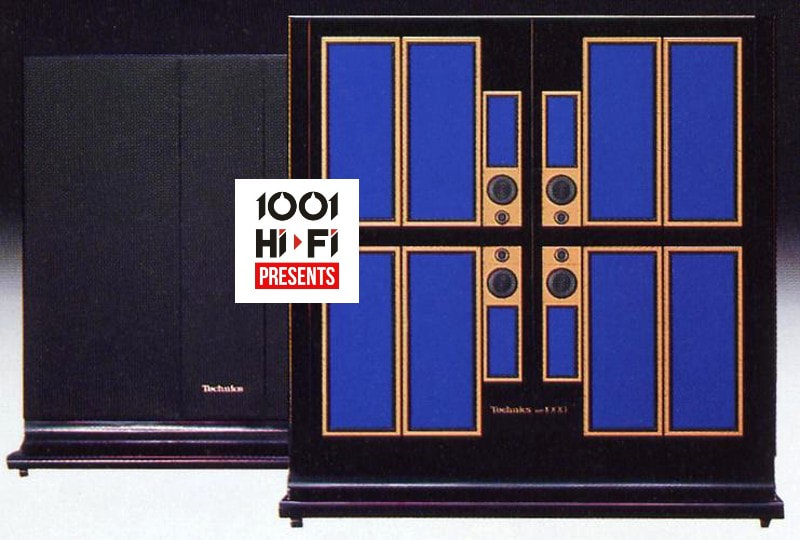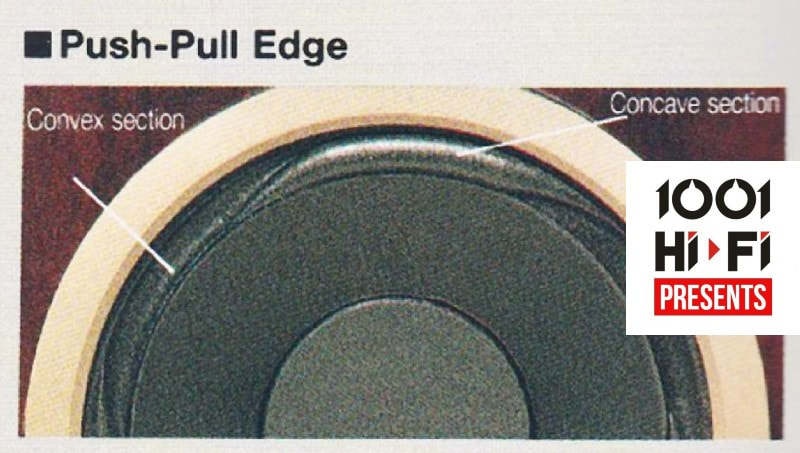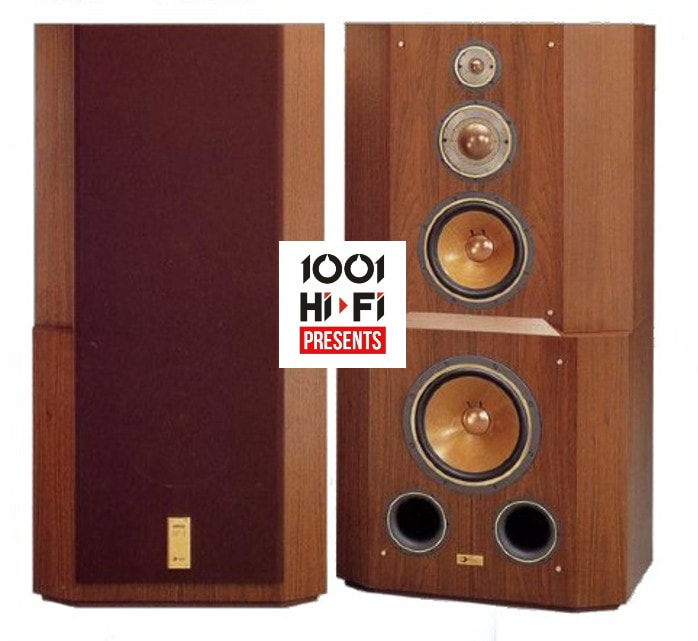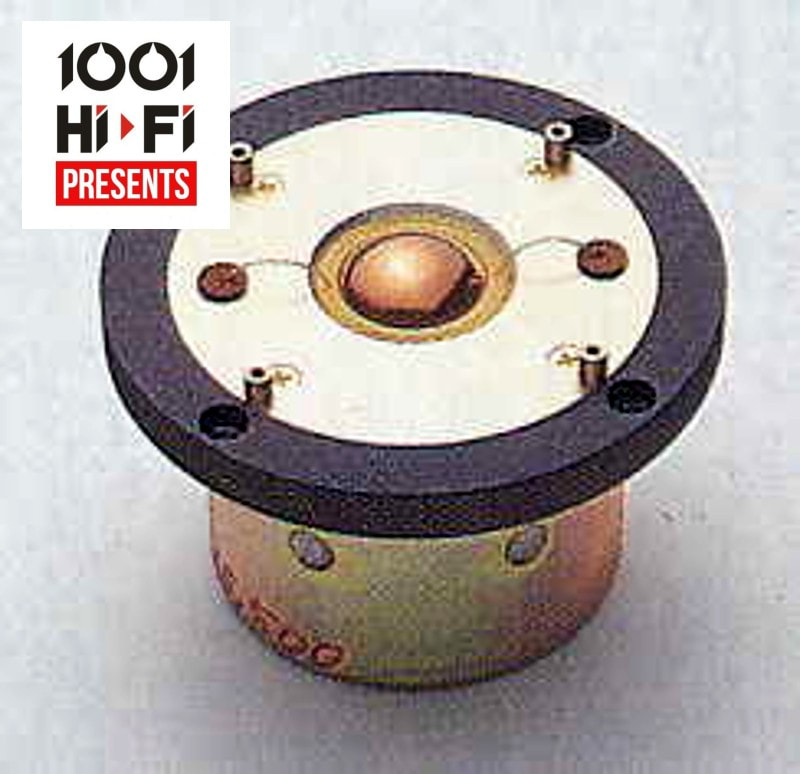GRUNDIG MONOLITH 190 (GERMANY 1980)
The first Laboratory Refence prototype of a 190 cm tall and 65 cm wide active sound wall was presented by Grundig at the 1979 Funkausstellung in Berlin. Due to large public interest a commercial model was released in 1980, this was the Grundig Monolith 190 Active Sound Wall, work of Dr. Arnold Glaab. The loudspeaker uses a system of three sets of vertically arranged speakers. It features 8 twin-series-parallel bass speakers, 7 series-parallel dome midrange speakers and 7 series-parallel dome tweeters for a 22-speaker wall of sound driven by 4 dedicated built-in power amplifiers. Each amplifier works in a frequency range determined by the active crossover network. Total power of a loudspeaker is 160 W nominal - 250 W music power (short term) while the frequency response is 20-25.000 Hz. The loudspeakers have to be connected to a pre-amplifier such as the Grundig XV 7500 which is capable of driving two sets of Grundig active loudspeakers. Each loudspeaker measures 68*192*46 cm, weighs 83 kg and the left and right loudspeaker are built in a mirror image speaker arrangement. Original sale price was 2800 DM per speaker.
ONKYO GRAND SCEPTER GS-1 (JAPAN 1984)
Takeshi Godai (former manager of the Panasonic speaker manufacturing factory) established Onkyo in april 1946 with the intention of addressing what he felt was a lack of satisfactory Japanese-made dynamic speakers. The word “onkyo” means “sound acoustics” in Japanese, and is the origin of a bold, simple, and concise brand image - (Osaka Denki Onkyo K.K.) Onkyo unveiled the Grand Scepter GS-1 in 1984, an all-horn-scheme speaker system designed by Hiroyuki Yoshii that was emblematic of the company’s ongoing pursuit of ultimate sound. The speaker was based on completely new theories of audio design and measurement and was evaluated highly in both domestic and overseas markets. An equally impressive power amplifier, the Grand Integra M510 was also introduced in 1984 as a partnering component. In 1991, a few years after its initial release, Hi-Fi professionals in France selected the GS-1 as recipient of the Joseph Leon Award. The Grand Scepter GS-1 has an all-horn configuration. The horn-loaded speaker has the characteristic of having good transient characteristics in principle, but it also has the disadvantage of having distortion in many time domains (multipath ghost distortion, reverb distortion, etc.). At Onkyo, theoretical analysis revealed that the horn-loaded horn type has very little high-order harmonic distortion in principle compared to other methods, and the ideal speaker system is realized by complete control of the horn-loaded horn speaker over a long period of time. Research and development were carried out. Multipath ghost distortion and reverb distortion are not necessarily unpleasant distortions, so they were sometimes used to create sounds, but Gran Scepter eliminates these distortions for the correct expression of music. Technical data: 2-way, 3-speaker, all-horn system | Power 300W (EIAJ) | Peak power 2000W | Frequency range 20Hz-20kHz | Impedance 8ohm | Dimensions: 630*1060*615 mm | Weight: 117kg.
PIONEER EXCLUSIVE MODEL 2401 (JAPAN 1983)
The Pioneer Exclusive model 2401 was introduced in 1983. This state-of-the-art loudspeaker was available for the mass market branded as Pioneer while for the professional audio sector it was available as TAD TSM-1. Since day one (1975), TAD Labs has been building only the highest quality, technologically leading loudspeaker chassis. Used in countless recording studios worldwide, the name TAD Labs has become an integral part of the professional scene. TAD's philosophy has remained the same to this day: Technological superiority paired with uncompromising authenticity. Introduced in 1983, the state-of-the-art TAD Labs TSM-1 studio monitor quickly gained an excellent reputation. The clear, precise sound, which reflects the energy and passion of live music like hardly any other loudspeaker, gives these TAD Labs models a near monopoly in the eighties. Even by today's standards these legendary transducers are a coveted collector's item. The TSM-1 (Exclusive model 2401) is a scientifically-designed monitor speaker system combining five TAD speaker components - two TL-1601a low-frequency loudspeakers, one TD-4001 high-frequency driver, one TH-4001 stabilized dispersion horn, and the TN-1 dividing network. It was designed for use in large studio control rooms. It provides both high power at all frequencies and superior transient response - a rare combination. Thanks to the use of two parallel-driven low-frequency loudspeakers, the maximum sound pressure level is a particularly high 126dB/W at 1m. Its dispersion pattern is critically controlled, based on tests of actual studio acoustics: response is smooth over a wide listening area, and consistently clear directivity can be enjoyed. Specifications: Impedance 4 ohm (when built-in network is employed) | Frequency range 29-20.000Hz | Input level 300 watts (rated) 600 watts (maximum) | Sound pressure level 98dB/W (1m) | Maximum sound pressure level 126db/W (1m) | Crossover frequency 650Hz | Dimensions 1100x900x712 mm | Weight 145 kg.
QUADRAL TITAN (GERMANY 1981)
Behind great success is often an interesting story. The TITAN-STORY begins in 1981, when the curtain rises for a sensational speaker, a conceptual sophistication of engineer Helmut Schaper. This dream speaker dominates the entire repertoire: abysmal bass, concise, natural sounding middle and crystal clear and finest details as well as most excellent incisively emphasizing treble. The loudspeaker pair has mirror imaged speaker arrangement. In addition, it had almost incredible performance values: 350 Watt continuous power and 600 Watt peak power handling! Even the immense weight of 115 kg documents that not only a noble speaker, but an acoustic total work of art was created here. In order to realize a fundamental bass reproduction, the TITAN I is using real transmission line principle. Specialty of the construction: Mr. Schaper ordered the bass speaker above the housing on the front side and folded the transmission line channel once on the housing bottom. The rear sound of the woofer could emerge out of the top of the housing cover. To reduce pipe resonances to a minimum, Mr. Schaper damped the sound channels with mineral fiber mats. Of course, the first TITAN convinced not only in the bass range - the specially developed cone midrange shone with exemplary transient response, and for the treble it was used a ribbon tweeter, which can reproduce high overtones particularly accurate in every detail. Also, the crossover corresponded highest quality requirements: extremely low manufacturing tolerances for all components made sure the speakers perfectly matched. With the addition of the quadral PA-01 external amplifier and ACO-01 crossover for mid and high frequency and an additional power amplifier the loudspeaker could be transformed into a active system. The TITAN continued to evolve and the 9th generation was introduced in 2016. Specifications: Type 3 Way | Principle Real-Transmission-Line | Frequency Range 16 Hz … 50 kHz ± 2dB | Crossover Frequencies 400 Hz/4000 Hz | Impedance 8 Ω | Woofer 320 mm Ø, Midrange 120 mm Ø, Tweeter Ribbon | Dimensions (HxWxD) 1500 x 540 x 505 mm | Weight, net 115 kg. (Source quadral Germany)
TECHNICS SB-AFP1000 (JAPAN 1988)
The SB-AFP1000 was an audio flat-panel speaker developed by examining as many as 80 types of test models and thoroughly performing computer simulations. The speaker used a unique twin-cabinet system with both sealed sections and open sections present at the same time in one cabinet. The speaker included eight 30-cm x 80-cm flat units for the low frequencies and four 13-cm x 32-cm flat units for the lower midrange frequencies. In particular, the diaphragm area for the low frequencies was equivalent to a cone woofer with a diameter of 152 cm, and at 124 dB the speaker attained amplitude of 1.27 mm (at 50 Hz). This enabled bass reproduction with low distortion. Characteristic of the AFP was that the bass was emitted in flat waves, and so the system was resistant to adverse effects such as due to indoor refection, and attenuation due to distance was extremely low. As a result, powerful, deep bass extended to the far corners of the space, and the listener was able to feel the subtle air fluctuations with his entire body. The cabinet was given a black-coating mirror finish. The first Audio Flat Panel AFP1000 was delivered to the world-renowned Vienna State Opera House for use in playing the performances of singers and orchestras during rehearsals. The modular construction of the AFP System allowed creation of various combinations from "wall to wall" systems to downsized models such as the SB-AFP100 and SB-AFP10.
TECHNICS SB-M10000 (JAPAN 1995)
The Technics SB-M10000 introduced in 1995 is a 4-Way 12-Speaker limited series loudspeaker system. The SB-M10000 used Dual Dynamic Drives (D.D.D.) that achieved flat response down to super-low frequencies. By developing a Kelton speaker system that alone is capable of the advantages of both sealed speakers and bass-reflex speakers, the SB-M10000 achieved ample frequency response reaching down to deep bass. The speaker was capable of easily reproducing deep bass with a sense of natural and magnificent scale as if floating. The speaker included four passive radiators with 27-cm cones for the low frequencies and four 22-cm cone woofers for driving. Unique push-pull edges reduced distortion by equalizing the amount of air displacement back and forth when amplitude occurs. The speaker included two 18-cm mid-low units using composite mica diaphragms for the lower midrange frequencies, a 6-cm pure-mica oval dome diaphragm unit for the upper midrange frequencies, and a 2.5-cm super graphite dome tweeter for the high frequencies. Given a multi-layer glossy veneer finish limiting diffraction reflection, the cabinet produced a tallboy form increasing the sound imaging in the space. The original sale price was 90.000 DM for a pair. According to some (yet unverified) sources there were only 8 pairs made. Technical data: Frequency response: 20Hz to 100kHz | Impedance: 4ohm | Dimensions: 486*1575*575 mm | Weight: 160kg. (Unofficial info: 8 pair worldwide, 45,000 DM/speaker)
YAMAHA GF-1 (JAPAN 1991)
The GF-1 from 1991 came to be known as an active speaker encapsulating an active crossover and a drive amplifier directly connected one-to-one with all speaker units. It was the culmination of the Yamaha HiFi speaker technology. It was designed with a two-part configuration (140 cm tall and 150 kg total) with the upper half housing a three-way speaker element and the lower half a YST super woofer element. Its four drive amplifiers and active crossover units per channel were attached as four independent modules to the back of the super woofer, and with a massive external power supply that itself weighed 25kg supplying each of the four amplifier modules with independent power it was a truly heavy piece of equipment. The crossover slope and cutoff frequency were completely fixed and could not be adjusted from the outside in any way, with only fine adjustments of up to ±2.5dB to each module’s input level available to the user. From this it can be seen that the developers intended the system to be perfectly tuned and did not intend the balance to be changed easily. The 3 cm tweeter and 8 cm midrange were of course made of pure beryllium, but rather than using the vacuum deposition process of the past it went as far as using a forged beryllium dome developed for and used in only this model. Its pair of large and small woofers (27 cm bass and 30 cm YST sub-bass) likewise used a Kevlar cone and forged beryllium cap specific to this model, and the magnet utilized a voice coil with reduced diameter and dendritic crystal aluminum-nickel to lighten the motion of the diaphragm system. The tweeter and midrange magnets were also composed of dendritic crystal aluminum-nickel. The gold deposition method was performed on each unit’s diaphragm in an effort to damp the slight squeal of beryllium and produce uniform tone across all units. Overall, it was built like it was meant to be the crowning glory, and if there was just one thing left undone it would probably be that it was not possible to use a forged beryllium woofer cone. As Yamaha’s speaker development changed course for a new era of focus on the home theater, the GF-1 put a period at the end of the pure beryllium development story that had played out since the NS-1000M. In 1992 a dedicated 100W/ch Class A power amplifier, the GFD-1, with external power supply was introduced to complement the GF-1 loudspeaker. It featured a 6-position source selector and a 23-position rotary attenuator. Its construction made possible to be used with any passive loudspeaker not just the Active GF-1.












